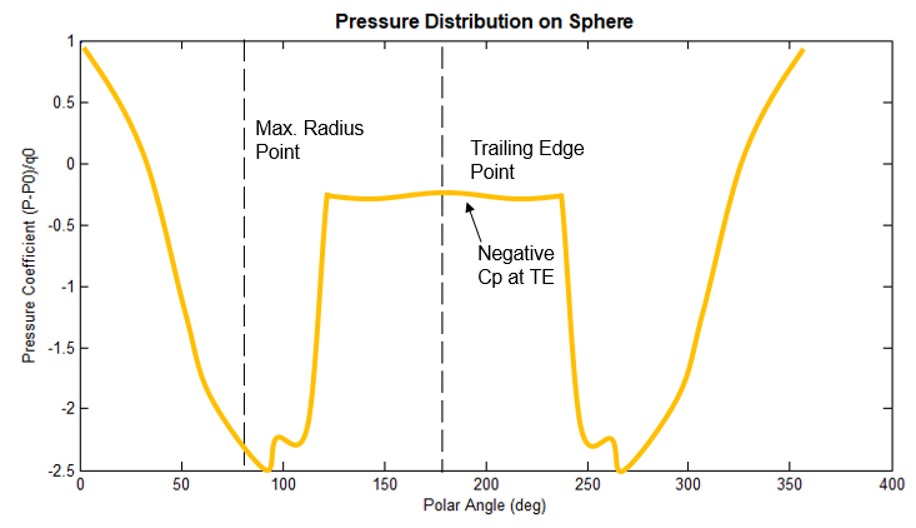The flow separation has a major contribution to the drag of bodies, especially the blunt bodies that shed vortices that draw their energy from the flow. In contrast, an airfoil has a very low region of flow separation at low angle of attack. As the flow angle increases, this poses an adverse pressure gradient at the trailing edge of the airfoil, causing flow to breakup and separate from the surface.
“Aerodynamic,” “Sleek,” and “Streamlined” are the common words to define the shape of vehicles that exhibit low aerodynamic drag characteristics. Generally, it means that the body should have a smaller region of flow separation.
Flow Separation
As flow moves over the surface of a body, pressure varies depending on the flow geometry; for instance, pressure decreases from the leading edge of the airfoil up to the point of maximum thickness over the airfoil. After reaching the maximum thickness point at the trailing edge of the airfoil, pressure again starts to increase until it reaches the trailing edge, where the pressure becomes equal to the free stream pressure.
It means that fluid faces a positive pressure gradient downstream of the airfoil after reaching maximum thickness. Pressure gradients will be stronger depending on the minimum pressure that occurs at the maximum thickness point and are termed “adverse pressure gradients.”. The boundary layer also grows as flow covers more and more area over the airfoil.
Since the slow-moving air in the boundary layer is low on energy, there might be a condition in which the pressure gradient is so much stronger that it creeps into the boundary layer as near-wall flow is slowed down to zero; hence, wall shear stress becomes zero. At this point, the flow takes an easy path and becomes detached from the surface of the body. This region of separated flow is called the “wake” region.

The Reynolds number has a direct impact on the amount of vortex shedding due to interaction of the boundary layer with the adverse pressure gradient. The vortex shedding behind a sphere can take many shapes depending on the Reynolds number; one of these is the out of phase vortex shedding that occurs at lower Re values and is called “Von Karman Vortex“.
Pressure Distribution Around A Sphere
So far, we have learned that an adverse pressure gradient on the body tends to separate the attached boundary layer flow and cause wake formation. This wake region consists of many eddies (regions of swirling flow) that may consist of different length scales depending on the nature of the flow and shape of the body. These eddies create a region of low pressure at the trailing edge of the body. Thus, the profile drag of the body further increases due to the increased imbalance of pressure distribution between the forward and rearward regions of the body. For example, the pressure distribution profile (in terms of pressure coefficient) on a sphere in polar coordinates is shown below:

First of all, being aerodynamic or sleek does not always mean having a lower frontal area, though this generalization is mostly true. For example, the sphere in the figure below has a ten times smaller diameter compared to the thickness of the airfoil, but the drag of the sphere is significantly higher than that of the airfoil. The reason for this drag rise is the contribution of the “Pressure Drag” or “Profile Drag”.

Pressure Drag
For an attached flow, momentum loss happens in the boundary layer (see the article on the Boundary Layer), where skin friction effects are dominant. Skin friction drag is proportional to the total surface area of the body in contact with the fluid (also called the “wetted area”). A drag force due to the pressure difference between the forward and rearward portions of the body is also exerted; this is called the profile drag, so sleeker bodies tend to have lower profile drag. The front of the body faces a major portion of total pressure as compared to the rear of the body, which is essentially at free-stream static pressure. By now, readers might ask, “If profile drag is due to the pressure difference, then why does a smaller sphere have higher profile drag compared to a much thicker airfoil”
This is a very valid question, and the answer lies in wake formation.

A turbulent boundary layer condition has more skin friction due to the Streamlining is very important to reduce the drag of any body, and this can be achieved in various ways. The purpose of streaming an object is to reduce its wake formation. In contrast to streamline bodies, bodies that do not shade vortex are called blunt bodies. This can be achieved by boat-tailing the blunt or non-streamlined objects. The final objective is to reduce the adverse pressure gradient downstream of the flow to achieve the attached flow. As a result, streamlined objects might have a large wetted area or skin friction drag, but overall drag is significantly reduced. strong mixing of fluid layers, but this mixing causes more momentum transfer from the outer or free-stream flow. This extra momentum helps turbulent flows overcome the incoming pressure gradient, such as the adverse pressure gradient behind a sphere or the flow near the trailing edge of an airfoil. Therefore, turbulent flow helps delay the flow separation.

